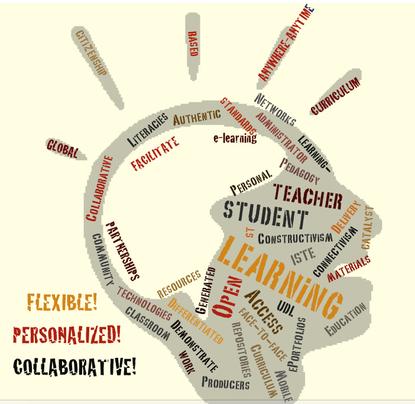Welcome to the Curriculum 2020 Directions Section
"Learning is something students do, NOT something done to students." Alfie Kohn
 Although the foundational basics in curriculum will continue to have importance, tomorrow's curriculum will need to place a greater emphasis on critical thinking and real world learning. Both collaborative and authentic learning will be used to promote global and digital citizenship. Students today and increasingly in the future will use technologies to access content, demonstrate their mastery of subjects, publish their work, maintain digital portfolios to showcase their skills and interact with others around the globe. Students in an English classroom may create digital media collaboratively to teach others about a book. Students in art may collaborate with students in physics or mechanics to design products. Through world video conferences students may collaborate with students of other nations to work on community projects.
Although the foundational basics in curriculum will continue to have importance, tomorrow's curriculum will need to place a greater emphasis on critical thinking and real world learning. Both collaborative and authentic learning will be used to promote global and digital citizenship. Students today and increasingly in the future will use technologies to access content, demonstrate their mastery of subjects, publish their work, maintain digital portfolios to showcase their skills and interact with others around the globe. Students in an English classroom may create digital media collaboratively to teach others about a book. Students in art may collaborate with students in physics or mechanics to design products. Through world video conferences students may collaborate with students of other nations to work on community projects.
Already today much learning takes place outside of the classroom. If you ask current students how they learned to use a particular tool, many will reply that they used Google or YouTube to find a simple video that illustrated the tool. Just as readily as they go to the web to find answers, they are also creating and publishing their own answers to questions through their own user generated content. Innovative teachers like middle school teacher Eric Marcos in California (see our page Kids Teaching Kids) are tapping into this creative potential by having their students produce video lessons that can be shared with students worldwide. Students of today and tomorrow will need to become increasingly more in control of their own learning.
The teacher will no longer hold centre stage, either physically or metephorically; attention will shift to create learner-centred curriculum that is not so focused on one answer solutions but more on inquiry and hands-on problem-based activity. Students and teachers will become partners in learning, with the teacher as a designer of curriculum and catalyst for student-constructed learning. That learning will not be limited to the classroom, but will move outside through real world projects and internships. Students will work on collaborative projects that will be based on their own interests or community interests. Partnerships created between schools, communities, business, and government will be needed to facilitate learning throughout both local and global communities.
Changes in the world of work necessitate changes in future curriculum
Curriculum will need to be flexible to fit the needs of an increasingly diverse student body. Using the principles of Universal Design, curriculum will be personalized and differentiated. Students will have options on how they approach learning. While one student may learn a subject in a team with or without a mentor, another may use digital media to progress step by step through a tailored learning program. Personalized education will fit the individual rather than the individual being forced to adapt to the educational system. Technology will be important but it will not be the driver. It will be the facilitator of good curriculum. Just as education will break beyond the walls of the classroom and provide options, the time for learning will also be flexible as more blended-hybrid classes and online options appear even in lower grades. The face-to-face class will still exist but the times for classes may become more flexible. Some students may take regular classes in summer and be off at different times.
As more and more classes become available online, students may not be so fixed to one school. This will create competition between schools and learning facilities locally and globally. Schools will need to make better use of their facilities and will consider becoming multi-use facilities that draw in partnerships from families, community and business. This view would make schools a hub of the community rather than just a node in a network. Schools may be used as centres for community activity, health centres and various other activities related to community partners and citizenship.
In keeping with a movement to open education and open resources, students will publish and exhibit their work, not just to their classmates and school but to the greater community. Textbooks will likely be digital and may just as likely be created by the students themselves. Already schools like those of the High Tech High district are creating and sharing digital and printed books and materials created by students and teachers. ( See our link Model Schools: High Tech High)
On the next pages under curriculum, we will delve into the key curriculum directions for 2020: 21st Century Learning, Constructivism, Inquiry Based Learning, Project Based Learning, Differentiated Instruction and Disruptive Innovations.
Next up, see Constructivism
